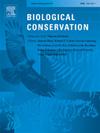确定热带生物多样性热点地区淡水保护的优先挑战和行动
IF 4.4
1区 环境科学与生态学
Q1 BIODIVERSITY CONSERVATION
引用次数: 0
摘要
热带淡水是全球生物多样性丧失率最高的水域之一。要有效保护热带淡水生物多样性,就必须以科学为依据,优先采取协调一致的行动,但迄今为止,我们仍然缺乏综合现有专业技术和知识的努力。在此,我们确定了热带生物多样性热点地区巽他兰淡水保护面临的最重要挑战,并提供了应对这些挑战的路线图。由 18 位专家组成的小组采用德尔菲技术达成共识,确定了威胁、研究需求以及社会和政策相关挑战等类别下的挑战。威胁根据其空间范围、严重程度和持续性的重要性进行排序,而研究需求以及社会和政策相关挑战则根据其阻碍保护的严重程度进行排序。排名靠前的挑战包括:(1) 威胁:森林砍伐、农业、城市化、水资源管理;(2) 研究需求:缺乏淡水生物多样性数据、系统生物学、了解多重压力因素和淡水生态系统的恢复能力;(3) 社会和政策相关挑战:淡水生物多样性不受重视、缺乏专业知识、缺乏系统的保护规划以及人口和富裕程度的增长。要应对这些挑战,就必须采取以下综合方法:加强研究人员和利益相关者之间的沟通与合作;开展科学宣传活动,提高公众对淡水生物多样性的认识和能力建设;实施最佳实践,减轻人类的负面影响;制定系统的保护规划;采用新型工具和技术,填补重要的知识空白。这项工作可以作为一种模式,为生物多样性以类似速度丧失的其他地区确定保护行动的优先次序。本文章由计算机程序翻译,如有差异,请以英文原文为准。
Prioritising challenges and actions for freshwater conservation in a tropical biodiversity hotspot
Tropical fresh waters experience one of the highest rates of biodiversity loss globally. Effective tropical freshwater biodiversity conservation requires prioritised and concerted action that is informed by science, but efforts to synthesise the available expertise and knowledge remain lacking to date. Here, we identify the most important challenges for freshwater conservation in the tropical biodiversity hotspot Sundaland, and provide roadmaps towards addressing them. A Delphi technique for consensus building, adopted across a panel of 18 experts, identified challenges under the categories of threats, research needs, and social and policy-related challenges. Threats were ranked by their importance in terms of the spatial extent, severity and persistence, while research needs, and social and policy-related challenges were ranked according to how severely they impede conservation. The top-ranked challenges were (1) threats: deforestation, agriculture, urbanisation, water management; (2) research needs: lack of data on freshwater biodiversity, systematic biology, understanding multiple stressors and resilience of freshwater ecosystems; and (3) social and policy-related challenges: low priority of freshwater biodiversity, lack of expertise, lack of systematic conservation planning, and growth of population and affluence. Addressing these challenges requires an approach that integrates improved communication and collaboration among researchers and stakeholders, scientific outreach to improve public appreciation of freshwater biodiversity and build capacity, implementation of best practices to mitigate negative human impacts, systematic conservation planning, and adoption of novel tools and technologies to address important knowledge gaps. This work can serve as a model for prioritising conservation actions in other regions that lose biodiversity at similarly rapid rates.
求助全文
通过发布文献求助,成功后即可免费获取论文全文。
去求助
来源期刊

Biological Conservation
环境科学-环境科学
CiteScore
10.20
自引率
3.40%
发文量
295
审稿时长
61 days
期刊介绍:
Biological Conservation is an international leading journal in the discipline of conservation biology. The journal publishes articles spanning a diverse range of fields that contribute to the biological, sociological, and economic dimensions of conservation and natural resource management. The primary aim of Biological Conservation is the publication of high-quality papers that advance the science and practice of conservation, or which demonstrate the application of conservation principles for natural resource management and policy. Therefore it will be of interest to a broad international readership.
 求助内容:
求助内容: 应助结果提醒方式:
应助结果提醒方式:


